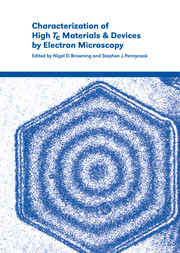Book contents
- Frontmatter
- Contents
- List of contributors
- Preface
- 1 High-resolution transmission electron microscopy
- 2 Holography in the transmission electron microscope
- 3 Microanalysis by scanning transmission electron microscopy
- 4 Specimen preparation for transmission electron microscopy
- 5 Low-temperature scanning electron microscopy
- 6 Scanning tunneling microscopy
- 7 Identification of new superconducting compounds by electron microscopy
- 8 Valence band electron energy loss spectroscopy (EELS) of oxide superconductors
- 9 Investigation of charge distribution in Bi2Sr2CaCu2O8 and YBa2Cu3O7
- 10 Grain boundaries in high Tc materials: transport properties and structure
- 11 The atomic structure and carrier concentration at grain boundaries in YBa2Cu3O7–δ
- 12 Microstructures in superconducting YBa2Cu3O7 thin films
- 13 Investigations on the microstructure of YBa2Cu3O7 thin-film edge Josephson junctions by high-resolution electron microscopy
- 14 Controlling the structure and properties of high Tc thin-film devices
12 - Microstructures in superconducting YBa2Cu3O7 thin films
Published online by Cambridge University Press: 21 August 2009
- Frontmatter
- Contents
- List of contributors
- Preface
- 1 High-resolution transmission electron microscopy
- 2 Holography in the transmission electron microscope
- 3 Microanalysis by scanning transmission electron microscopy
- 4 Specimen preparation for transmission electron microscopy
- 5 Low-temperature scanning electron microscopy
- 6 Scanning tunneling microscopy
- 7 Identification of new superconducting compounds by electron microscopy
- 8 Valence band electron energy loss spectroscopy (EELS) of oxide superconductors
- 9 Investigation of charge distribution in Bi2Sr2CaCu2O8 and YBa2Cu3O7
- 10 Grain boundaries in high Tc materials: transport properties and structure
- 11 The atomic structure and carrier concentration at grain boundaries in YBa2Cu3O7–δ
- 12 Microstructures in superconducting YBa2Cu3O7 thin films
- 13 Investigations on the microstructure of YBa2Cu3O7 thin-film edge Josephson junctions by high-resolution electron microscopy
- 14 Controlling the structure and properties of high Tc thin-film devices
Summary
Introduction
Thin films of the high-temperature superconductor, YBa2Cu3O7, may be synthesized as highly oriented structures having a high degree of homogeneity as compared with bulk processed materials. These thin films exhibit some of the best transport properties of high-temperature superconductors (HTSC), particularly the highest superconducting critical currents as a function of temperature and magnetic field. The microstructure of films of different orientation is composed of arrays of specific crystallographic defects which may include, for example, low-angle grain boundaries, (110) twin boundaries, 90° domain boundaries, other misoriented regions or grains, stacking faults, antiphase boundaries, second phases, etc. The surface and interface structure may vary considerably, a smooth surface being essential for device fabrication. Thin-film synthesis also provides methods for fabricating or isolating localized crystallographic interfaces, such as grain boundaries, for transport studies. Therefore, in addition to their importance for technological applications, HTSC thin films may also serve as model systems for studying fundamental behaviors of these materials. In understanding properties it is essential to characterize the microstructure in as much detail as possible. In this chapter we will discuss the microstructure of YBa2Cu3O7 (YBCO) thin films as characterized by transmission electron microscopy (TEM), with emphasis on the interface structure of films having a-axis and (103) orientation, and of individually fabricated boundaries synthesized using a-axis oriented films.
Grain boundaries
YBa2Cu3O7 (YBCO) thin films are grown in situ by a variety of vapor phase deposition techniques usually with either the c-axis or a(b)-axis normal to the plane of the film [12.1, 12.2]. We will refer to the films by their normal orientation.
- Type
- Chapter
- Information
- Publisher: Cambridge University PressPrint publication year: 2000

